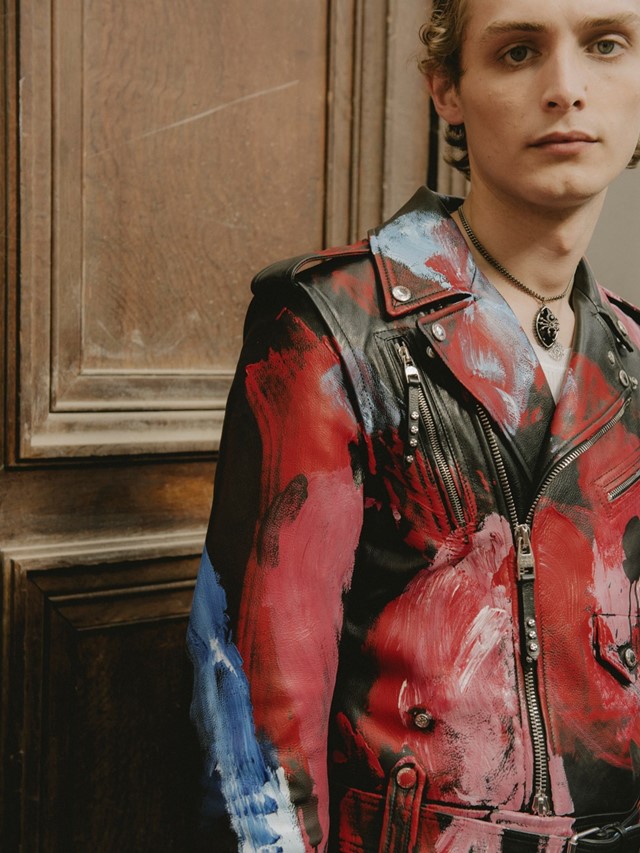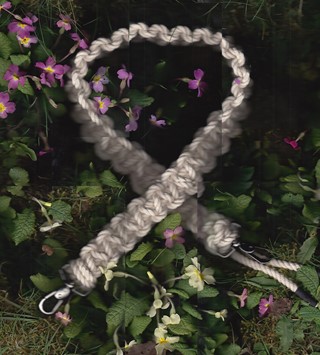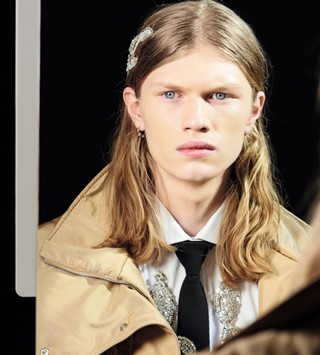How Francis Bacon Informed Alexander McQueen S/S19 Menswear
- TextTed Stansfield
The British artist had a profound impact on Sarah Burton’s latest men’s offering for the house, reveals Alister Mackie, the show’s stylist and consultant
The story of Sarah Burton’s Spring/Summer 2019 men’s collection for Alexander McQueen begins in Tate Britain, in the art gallery’s All Too Human: Bacon, Freud and a Century of Painting Life exhibition, which opened in February. Here, Francis Bacon and Lucian Freud’s work is hung alongside that of other British painters who strove to explore the human figure – and also one photographer, John Deakin, whose images formed the basis of many of Bacon’s paintings. After Burton’s womenswear show in March, she met with Alister Mackie, the menswear show’s stylist and consultant and Another Man’s creative director, and the two began work on this season’s collection, with this exhibition and the idea of “a painter” in mind.
Bacon, Deakin and Freud
This influence – of “the painter” – was informed by Bacon and Freud, who are two of the most celebrated figures in modern British art. “It made sense because Francis Bacon was such a hero of Lee McQueen’s,” says Mackie. “Francis Bacon, John Deakin and Lucian Freud are all men of London, which Lee was, and I think it’s a constant source of inspiration for us, this idea of the city.” Working together, they drew not only on the lives and work of these three artists, but the stark contrast between the chaos and creativity of their studios, and the repression of Britain during that the 1950s and 1960s – for while Beacon, Deakin and Freud were gay, homosexuality was still illegal. Burton and Mackie channelled this dichotomy into these clothes, beginning with the tailoring.


The Tailoring
Keeping Bacon, Deakin and Freud in mind, Burton – who is described as a “master tailor” by Mackie – took some of the techniques she had been exploring in the women’s collection and applied them to the men’s; slicing up formal pieces such as the tuxedo in an act that reflected the duality of these men who were so buttoned-up and British on the one hand, and so aggressively creative on the other. It’s a sensibility that reflects the spirit of Alexander McQueen, too – “extreme craftsmanship and with a touch of anarchy,” as Mackie puts it. “To me, McQueen is about storytelling and romance and reality and London and extreme craftsmanship, but also punk,” he continues. “Lee would make something incredibly magnificent and labour-intensive but then he’d rip it in half.” In the same way, Burton crafted pieces with her trademark couture-level precision and sliced them up: trench coats were cut at the sleeve (right up to the elbow), or else at the midriff; shirts were severed at the cuff; trousers at the hem.


The Prints and the Body Paint
This sense of anarchy wasn’t only present in the tailoring; it was in the prints, too, which were lifted from the work of Bacon. Not his paintings, though, as Mackie explains – “They were from when he was cleaning his brushes… The marks were completely random, but they were in these beautiful colours, really bright, quite different to his work, but from his head.” Born in Bacon’s subconscious, these marks took centre stage in the collection, in the fabric that the suiting was cut from but also on the leathers and one model’s body (as painted by the show’s make-up artist, Miranda Joyce). As well as referencing Bacon, this element of the collection also paid homage to Alexander McQueen’s own archive: specifically, the house’s first men’s show (Spring/Summer 2015) back in 2004, which saw models’ heads and bodies splashed in bright pink and blue pigment like participants in Hinduism’s Holi festival.


The Casting
Working with casting director Jess Hallett, Burton and Mackie were keen to select models who reflected the inspirations of the show, and added to its narrative. “Each person who walked in the show was cast as an individual,” Mackie explains. “Someone you might see Soho at the time – whether it’s a businessman, or someone in a sex shop, or a leather boy, or an aristocrat – hey’re characters in a narrative who could have been included in the life of Francis Bacon, or in the photographs of John Deakin.” With punk characters and rich boys thrown together, the models really did look like they belonged to Soho’s art scene during the 1950s and 1960s. Each was individually fitted, some multiple times, by McQueen’s atelier, which travels to Paris. “It’s a very luxurious process because everything is bespoke,” Mackie comments. “Sarah is a perfectionist, and that’s why it looks so tight.”
















